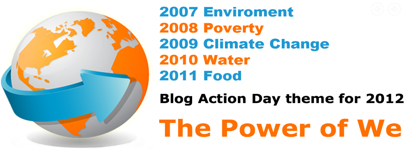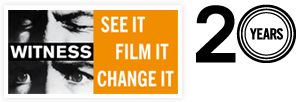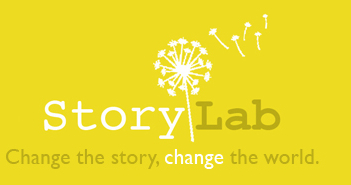For the fifth year, I’m participating in Blog Action Day; the theme this year is “The Power of We.” It’s about growing movements of people working together for positive social change.

From the Blog Action Day organizers:
Whether using digital tools like blogs, social networks and mobiles, or meeting face to face in local community halls, neighbours house, andpublic streets. Greater numbers of people have been coming together to make change, either for their own communities or the world at large. … we see The Power of We as a celebration of people working together to make a positive difference in the world.
I’ve never found it difficult to tie in story and storytelling to the Blog Action Day themes, and “the power of we” is especially easy. You can check out my Links to Social-Change Story Initiatives and Resources for more.
I’ve seen and reported on countless examples in which stories are collected and shared to create social change. Here are just a few that I’ve come across in the past year:
-
- StoryLab (see pilot projects at that link) is an initiative of the Center for Digital Storytelling, a “hub for innovation with a big aim: to radically improve public conversation in the U.S. and around the world. Everybody talks about it, but CDS actually knows how to do it. To change the world, you first have to change the story.”
- Social media is perhaps one of the most powerful representations of the “power of we” of our times, and venues like Facebook Stories collect these narratives. 6 stories of life-changing social media connections is another source of stories of how social-media connects us, inspires the “power of we”, and changes lives and the world.
- Co-Creative Communities: Forum and Lab/Storytelling Futures for Community Arts and Media is a conference next month (Nov. 8-9) in Queensland, Australia, about “collaborative media production practices that have emerged at the intersection of community-based media, arts and cultural development, and which have fundamentally different methods and values from more professional or commerical examples of participatory media. They actively encourage social learning and ‘bottom up’ participation through creative expression and storytelling.” Among the conference activities, leading researchers, practitioners, and activists will discuss models and best-practice principles for working with communities to help tell their stories and create positive change.
-
- WITNESS uses video to open the eyes of the world to human
 rights violations. WITNESS empowers people to transform personal stories of abuse into powerful tools for justice, promoting public engagement and policy change.
rights violations. WITNESS empowers people to transform personal stories of abuse into powerful tools for justice, promoting public engagement and policy change. - My Networked Life: is a documentary-style video series that takes viewers around the world for a look at how young professionals, entrepreneurs, artists and students are using connected technology to achieve goals and realize dreams. “These stories are personal, they are real and they are powerful,” the site says. Social change may be arguable here, especially because Cisco is behind the site, but the “power of we” here is the power of stories to inspire.
- WITNESS uses video to open the eyes of the world to human
- A story from this year that generated enormous “power of we” was that of Caine’s Arcade, which I wrote about here. The story of the cardboard arcade made by 9-year-old Caine Monroy inspired children and adults everywhere to build their own arcades The story of Caine generated the Global Cardboard Challenge, inviting the world to play while raising funds to foster creativity and entrepreneurship in kids, as well as the Imagination Foundation, established to find, foster, and fund creativity and entrepreneurship in kids. Caine’s story shows that sometimes a single story inspires hundreds of others (while many of these other initiatives comprise collective stories that inspire individuals).
- With stunning design and technology, Faces of Drunk Driving
 tells and collects stories of drunk drivers in the hope of saving lives.
tells and collects stories of drunk drivers in the hope of saving lives.
- The site of the GlobalGiving Storytelling Program says the organization has learned “that one of the best ways we can contribute to social change is to develop better feedback loops.” The organization is committed to finding better ways for stakeholder voices to be heard in the development process. With initial funding from the Rockefeller Foundation, the Storytelling Project is an experiment in collecting community feedback. GlobalGiving has started by recording thousands of stories told by people from areas where GlobalGiving partners work.” The site offers resources for collecting stories in local communities, as well as other ways to get involved and donate.
- Earlier this year when the Komen Foundation momentarily defunded Planned Parenthood breast-cancer screenings, sites sprang up like Planned Parenthood Saved My Life (not affiliated with Planned Parenthood) to show the value of the reproductive-health organization, not just regarding breast concur, but also its other services. This one “posts stories of women whose lives were saved or changed because they had access to affordable health care like cancer screenings through Planned Parenthood.”
- Similarly, sites like one from the National Women’s Law Center share and collect stories of people positively impacted by the Affordable care Act (so-called Obamacare). In fairness, at least one site collects negative stories; however, at the one I saw, only positive stories are posted.
Bottom line: Want to generate the “power of we?” Want to inspire people to work together for positive social change? Tell stories.


